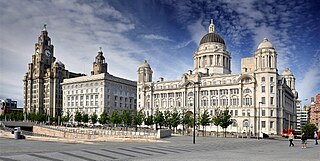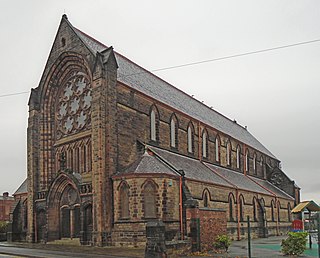
Merseyside is a ceremonial and metropolitan county in North West England. It borders Lancashire to the north, Greater Manchester to the east, Cheshire to the south, the Welsh county of Flintshire across the Dee Estuary to the southwest, and the Irish Sea to the west. The largest settlement is the city of Liverpool.

The Mersey Ferry is a ferry service operating on the River Mersey in north west England, between Liverpool to the east and Birkenhead and Wallasey on the Wirral Peninsula to the west. Ferries have been used on this route since at least the 12th century, and continue to be popular for both local people and visitors.

Liscard is an area of the town of Wallasey, in the Metropolitan Borough of Wirral, Merseyside, England. The most centrally located of Wallasey's townships, it is the main shopping area of the town, with many shops located in the Cherry Tree Shopping Centre. At the 2001 census the population of Liscard local government ward was recorded at 14,301, increasing to 15,574 at the 2011 census.

Seacombe is a district of the town of Wallasey, on the Wirral Peninsula, England. Administratively, Seacombe is a ward of the Metropolitan Borough of Wirral in Merseyside. Before local government reorganisation on 1 April 1974, it was part of the County Borough of Wallasey, within the geographical county of Cheshire. At the 2001 Census, the population of Seacombe was 15,158,, increasing to 15,387 at the Census 2011.

The Wirral Railway was a railway network in the northern part of the Wirral Peninsula, England. Its route was from Birkenhead Park in the east of the Wirral to West Kirby in the west. A branch off this line at Bidston went north to Secombe and New Brighton. It was incorporated in 1863 as the Hoylake Railway, running from Hoylake to Birkenhead Docks. After changes of name and of ownership, it was purchased by the Wirral Railway Company Limited in 1884. The network was extended to West Kirby, New Brighton, and Seacombe, and to Birkenhead Park station where it joined the Mersey Railway, enabling through trains through the Mersey Railway Tunnel to Liverpool. In the 1923 grouping the Wirral company became part of the London, Midland and Scottish Railway, which electrified the line in 1938, allowing passenger services to be integrated with the Liverpool urban system. Most of the Wirral Railway network is still in use today as part of the Wirral Line of the Merseyrail rail network.

Wallasey is a town in the Metropolitan Borough of Wirral, Merseyside, England. Within the boundaries of the historic county of Cheshire, it is at the mouth of the River Mersey, on the north-eastern corner of the Wirral Peninsula. At the 2011 Census, the population was 60,284.

New Brighton is a seaside resort and suburb of Wallasey, at the northeastern tip of the Wirral peninsula. It lies in the traditional county of Cheshire and is currently administered as part of the Metropolitan Borough of Wirral in Merseyside, England, It has sandy beaches which line the Irish Sea and mouth of the Mersey, and the UK's longest promenade.

The Wirral Peninsula, known locally as the Wirral, is a peninsula in North West England. The roughly rectangular peninsula is about 15 miles (24 km) long and 7 miles (11 km) wide, and is bounded by the Dee Estuary to the west, the Mersey Estuary to the east, and Liverpool Bay to the north.

Wallasey is a constituency in Merseyside created in 1918 and represented in the House of Commons of the UK Parliament since 1992 by Angela Eagle, a member of the Labour Party.

Seacombe railway station was located in Wallasey, Wirral, England. The station was opened by the Wirral Railway in 1895 and closed in 1963.

Liscard and Poulton railway station was located in Wallasey, Wirral, Cheshire and was an intermediate station on the Seacombe branch of the Wirral Railway.

Poulton is an area of the town of Wallasey, in the Metropolitan Borough of Wirral, Merseyside, England. It is located on the Wirral Peninsula and bordered by Liscard to the north, Egremont to the north east and Seacombe to the east. The West Float, is to the south.

Wallasey Village is a district and suburb of Wallasey, in the Metropolitan Borough of Wirral, England. At the 2001 Census the population of the area was 8,550.

Saughall Massie is a village on the Wirral Peninsula, Merseyside, England. It is part of the Moreton West & Saughall Massie Ward of the Metropolitan Borough of Wirral and the parliamentary constituency of Wallasey. A small village primarily made up of large fields owned by local farmers, it is bordered by Greasby, Meols, Moreton and Upton. At the 2001 census Saughall Massie had a population of 1,260.

Wallasey Corporation Tramways operated an electric tramway service in Wallasey between 1902 and 1933.

The Church of Our Lady Star of the Sea is in Wheatland Lane, Seacombe, Wallasey, Wirral, Merseyside, England. It is an active Roman Catholic parish church in the diocese of Shrewsbury, and its parish is combined with that of St Joseph, Wallasey. The church is recorded in the National Heritage List for England as a designated Grade II listed building.
Wallasey is a town in Wirral, Merseyside, England. It contains 34 buildings that are recorded in the National Heritage List for England as designated listed buildings. Of these, three are listed at Grade II*, the middle of the three grades, and the others are at Grade II, the lowest grade. Originally a number of small separate villages, the town grew in the 19th century to become a dormitory town for Liverpool. It also contains part of Birkenhead Docks. There are only four listed buildings dating from before the 19th century, namely the isolated tower of a medieval church, a house, a rectory, and a former grammar school. The later listed buildings include houses, churches, public houses, buildings associated with the docks, the town hall, part of a school, a watercourse, and two war memorials.

New Brighton Pier was a pleasure and fishing pier in New Brighton, Wallasey in England, built during the late 1860s at a length of 600 feet (180 m).


















